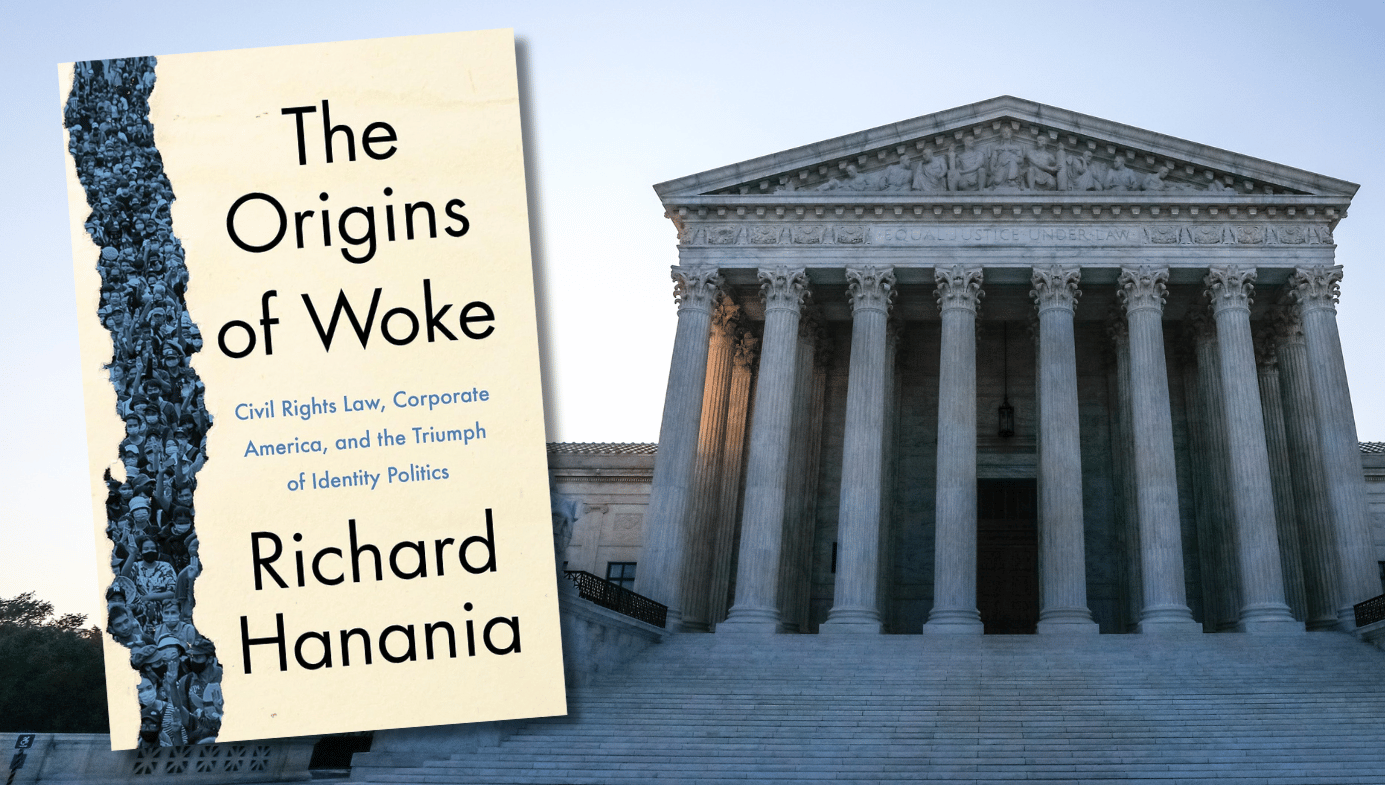Civil Rights and Wrongs
Richard Hanania’s new book is a welcome entry to the conversation about wokeness, but his power-based perspective is incomplete.

A review of The Origins of Woke: Civil Rights Law, Corporate America, and the Triumph of Identity Politics by Richard Hanania, 288 pages, Broadside Books (September 2023)
What is “wokeness”? Some think of it as a set of ideas, or even a way of expressing those ideas. Some think of it as a set of political goals. Some think of it as a set of institutional structures or social incentives. Some think of it as a psychological quirk that yearns for a new religion or source of comfort in a therapeutic and risk-averse age. Different ways of thinking about wokeness affect the stories we tell about where it came from. People concerned with philosophy might talk about the influence of the Frankfurt School or Michel Foucault. People concerned with psychology might talk about the effects of social media. People concerned with institutions might talk about the ease with which a small number of activists can destabilize a large organization. People concerned with incentives might talk about the use of identity categories to market products.
A separate question concerns how to delineate wokeness. Debates about race, gender, class, and culture have always been part of American politics. The 1960s saw the rise of the civil-rights movements and the emergence of feminism’s second wave. The culture wars during the 1990s cut through the American academy and feminism entered its third wave. Progressives and conservatives alike pressure liberal centrists not to distinguish the wokeness of today from those earlier social movements. What makes it so different? Why draw the line here and say it’s gone too far? Progressives make this comparison to cast a more favorable light on current struggles, while conservatives make it to cast a less favorable light on past victories.
In The Origins of Woke, Richard Hanania argues that wokeness is primarily legal and political in nature, and that its history is traceable to civil-rights-era developments in law and policy. “Intellectuals tend to put a great deal of faith in the importance of ideas,” he writes, but that leads them to get this phenomenon wrong. According to the intellectualist story, which I’ve discussed in my review of Cynical Theories and my forthcoming assessment of The Identity Trap, philosophers like Marx or Foucault somehow planted the seed of wokeness in college students’ minds, with the help of their hyper-lefty professors. Ergo, the antidote to wokeness is the work of liberal intellectuals, like John Stuart Mill, which tells us how to evaluate philosophical and political theories on their merits according to our best habits of rationalism and empiricism.

Hanania looks down on this sort of intellectualist account. In common with many woke advocates, he describes the “marketplace of ideas” as a “myth” and argues that the best way to understand politics is by following events back through the tendrils of political power to their source—the federal bureaucracy. For instance, there is “a problem for the idea that wokeness came from the university[:] the fact that identity politics had to originally be forced upon much of higher education by Washington, with the Department of Health, Education, and Welfare originally coercing schools like Columbia and UC Berkeley to adopt quota-based faculty hiring during the early 1970s.”
Debates about the nature of concrete political systems and their relation to ideologies are not new, but their emergence within the anti-woke movement may point to a new level of sophistication within those circles. Materialist (or realist) and intellectualist (or idealist) accounts of political history and theory have always been at odds, and for every theory that accounts for political behavior in terms of people’s genuinely held ideas, we can offer a corresponding theory that accounts for political behavior in terms of people merely pretending to hold those ideas in order to gain some material benefit or avoid some material harm. On the (broadly speaking) Left, you can see this debate play out among Marxists, moralists, and misinformation theorists, for example. It is also part of international-relations theory, dividing the hard-headed realists from the liberal idealists. Idealism is pretty standard in an anti-woke discourse saturated with idea-centric thinking, and so Hanania’s book is in many ways a welcome entry to the conversation. On its own, though, his power-based perspective is just as incomplete.
For Hanania, “wokeness has three central pillars”: “The belief that disparities equal discrimination” (when those disparities favor the “advantaged” groups), “speech restrictions,” and “human resources (HR) bureaucracy.” These first two pillars have been called “equalitarianism” and “cancel culture,” respectively. It’s Hanania’s focus on the third—“how wokeness is enforced at an institutional level”—that makes his book distinctive. In particular, Hanania disagrees with Christopher Caldwell, author of the 2020 book The Age of Entitlement, about the relationship between civil-rights legislation and wokeness. According to Hanania, it was not civil-rights legislation itself that generated American wokeness, it was the interpretation and enforcement of that legislation by courts, administrative agencies, and other bureaucracies, both public and private. Hanania writes that, in fact, “later innovations mostly came from decisions made by and negotiations between the courts, big business, and the federal bureaucracy. Most of the time, these innovations ignored, or even contradicted, the plain text of the 1964 law and the original intent of those who wrote and voted for it.”
In many ways, Hanania is right that wokeness doesn’t go much further than liberal legal and institutional regimes with a long pedigree. He identifies three such regimes: affirmative action, disparate-impact law, and anti-harassment law. Affirmative action is a nicer name for race-consciousness and racial preferences (as well as sex and gender preferences, sometimes). Disparate impact, part of the canon of civil-rights law for over 50 years, is basically the same as Ibram X. Kendi’s widely derided idea that disparities between groups can only be caused by discrimination—that such disparities are, in fact, themselves discrimination ipso facto.
And yet there are elements of contemporary wokeness that are left out of this. The notion of “lived experience,” the idea that one’s “existence” might somehow be “invalidated” by disagreement, the racialization and genderization of politics and the politicization of everything, television dialogue that sounds like Tumblr, art being subject to political tests, the euphemism treadmill, cancellations, social-media mobs, gender discourse, and the proliferation of identities: surely these are all parts of wokeness, but they’re contemporary, and organic in the sense of culture begetting culture. None of them is a necessary traveling companion to the federal bureaucracy’s interpretations of civil-rights law.
Many of the details Hanania includes are eye-opening. While the constitutionality of affirmative action hung by a thread at the Supreme Court, it was mandated for government contractors by executive order. The book describes at length the excruciating and “bizarre system” employers must implement in order to meet this sort of requirement. The Civil Rights Act of 1964 included provisions aimed specifically at preventing the sort of disparate-impact standard that eventually emerged from it, and the idea of “reverse discrimination”—what came to be known, in a very strange euphemism, as affirmative action—was broached in Congressional debates about the bill and was broadly seen as undesirable. Hanania quotes Supreme Court Justice Harry Blackmun, who wrote in a concurrence that, by passing the Civil Rights Act, Congress “probably thought it was adopting a principle of nondiscrimination that would apply to blacks and whites alike.” Indeed, this is just colorblindness versus race consciousness.

The majority opinion from the DC Circuit in a landmark 1970s sexual-harassment case, Barnes v. Costle, included a footnote explaining that a “bisexual superior who conditions the employment opportunities of a subordinate of either gender upon participation in a sexual affair ... would not constitute gender discrimination because it would apply to male and female employees alike”—a truly odd notion completely foreign to our contemporary understanding of sexual harassment. The idea of a “hostile work environment” grew out of that, as courts began to find employers liable for the discomfort their employees caused each other, and more and more speech and other conduct that might cause more discomfort to members of one group than another was called harassment. By calling this an issue of free speech, Hanania seems to agree with progressive commentators that the restrictions placed on people by “private governments” like employers are part of politics just as public laws are. At the same time, though, Hanania believes these private governments’ actions always trace back to the federal government, and in particular its judiciary and administrative agencies.
The ballooning private human-resources bureaucracy emerges partly from judicial and administrative fiat and partly from a desire on the part of corporations, universities, and other organizations to avoid litigation, in particular by following ever-changing “best practices” in their industry. This often involves hiring an ever-increasing number of bureaucrats. Civil-rights litigation might even eventuate in injunctive relief which requires bureaucracies to be set up, and losing defendants must pay the legal fees of plaintiffs, making civil-rights lawsuits a kind of self-fueling perpetual motion machine. In response, organizations all adopt the same procedures and take advice from the same consultants, leading to “standardization” and “homogenization.” However, the ideas-don’t-matter approach seems to leave unexplained the motivations of these judges, bureaucrats, and consultants themselves.
A recurring theme for Hanania is that ambiguous standards—“vagueness wrapped in jargon”—can actually be more taxing than more overtly stringent ones, if the stringent standards are at least clear. For instance, pure racial quotas on hiring might have been easier to understand and implement than the disparate-impact standard of discrimination, which demands that nothing be done that disproportionately negatively affects women or members of minority groups. Cleverly, Hanania notes: “Data shows [sic] that ‘learning loss’ from school closures hit poor and minority students the hardest. Yet this has not created any issues surrounding disparate impact. Meanwhile, the Biden Justice Department has gone after state bans on mask mandates on the grounds that they might create special dangers for disabled students and deny them a right to an education.” On the reverse side, we can recall the Trump Education Department hilariously calling Princeton University President Christopher Eisengruber’s bluff in 2020. Eisengruber had said that “racism and the damage it does to people of color nevertheless persist at Princeton as in our society.” So the Trump administration opened an investigation into Princeton for possible violations of civil-rights law.
In a libertarian mode, Hanania seems to suggest that the ambiguity serves the governmental bureaucracy more than anything else, by giving it wide latitude to constantly reinterpret its own strictures. “Understanding the role of the state,” he writes, “can explain much of what is puzzling about wokeness as a cultural phenomenon.” (Given Hanania’s reputation as a firebrand, I was surprised by how much of the book comes down to an American legal conservatism that was pretty standard 15 years ago when I spent a year in law school. He is always making originalist noises, and the book is shot through with doubts about the Constitutional legitimacy of the administrative state.) This also scores a point against the theory of “woke capital,” according to which wokeness is, for one reason or another, the political goal of corporations and rich individuals.
Hanania even frames the woke bureaucracy as a cultural equivalent of the “central planning” of socialist economics, a social-engineering project that fails to recognize the virtues of market dynamics and the invisible hand; he writes with a faith many libertarians lack that “large socioeconomic disparities that are not based in underlying differences in productivity cannot exist in a market system.” He goes so far as to say that government hiring currently operates on a “racial spoils system” analogous to the quid-pro-quo, cronyism, and nepotism characteristic of American government hiring in the mid-1800s. A big factor here, for Hanania, is the elimination of standardized tests in hiring on the logic of disparate impact; such testing has been largely but not universally eliminated in the private sphere as well.
On Hanania’s account, powerful interests serve wokeness because the government makes them do so. Even our everyday racial classifications themselves were, according to Hanania, products of government policy which grouped together people (“Spanish-speaking,” “Asian”) who wouldn’t have seen themselves as belonging together. That said, it’s not clear that the government is all-powerful in this regard. Colloquial use of the term “Asian” in the United States, for instance, refers only to East Asians, but government definitions include South Asians as well. Here again, Hanania echoes woke ideas on the meta-level, agreeing that race is a social (or political) construction, while still having real effects.
But does the federal government require corporations to make rainbow-colored versions of their logos, or tweet in support of black trans women? It may have played a crucial role in the history of wokeness, but that doesn’t mean it is wedded to that role. Hanania writes that everyday wokesters are like a religious community developing their faith based on a priestly class’s interpretation of a holy text (the federal judiciary and bureaucracy’s interpretation of civil rights law). The belief that hate speech is illegal, held (Hanania says) by a quarter of Americans, “can be seen as an understandable mistake, given the state of anti-harassment law.” I don’t think that mistake is understandable at all, and the Supreme Court that ruled 8-1 in favor of the Westboro Baptist Church in Snyder v. Phelps can hardly be held responsible for it either way. And it’s not just lay beliefs—although The Origins of Woke tells a story about how judges and government bureaucrats imposed woke ideas on American institutions, it says little about why those nefarious actors would find such a prospect attractive to begin with.
A related recurring theme is the intellectual incoherence of the political center. This theme occurs on multiple levels. First, lurking in the background, is Hanania’s sometimes implicit critique of centrist anti-woke writers, who think things suddenly “went too far” when people started calling them names in the 2010s but voiced no objections to identity politics before that. Second, Hanania says outright that a lot of centrist ideas are nonsense that enables wokeness.
For instance, the diversity rationale for affirmative action came from the compromise majority opinion in Bakke, a 1978 Supreme Court case. In that case, the Court struck down by a 5-4 majority the racial quota system at UC-Davis’s medical school, while upholding an affirmative-action system tailored to the interests of diversity in higher education. Justice Lewis F. Powell, Jr. was the swing vote and wrote the opinion; he was the only one who actually agreed with both parts of it—the incoherent compromise, in Hanania’s view. Liberal Justice Ruth Bader Ginsburg also found the diversity rationale questionable, calling it a way of enforcing quotas “through winks, nods, and disguises.” And if a single policy like affirmative action is an incoherent compromise, why would we expect the whole edifice of “wokeness”—an edifice named and discussed more by its opponents than by its proponents—to be a coherent philosophical theory?
Hanania goes too far himself in treating some of these cases, though. He suggests that Justice Powell created from whole cloth the concept of “diversity,” which came to dominate thinking about identity. But while this might have been a new way of talking about it, discussions of pluralism and integration were certainly common at that time. It seems sort of pedantic to focus on the supposedly novel word choice rather than the concept which was already in the air. Anyway, the word “diversity” appears in amicus briefs from colleges themselves, most notably Harvard, which are cited in the decision. This makes it seem that Hanania’s clever reversal is just wrong. “Diversity” was a concept among college administrators which was then taken seriously as an institutional interest by the Court. Further, the notion that there was no practical difference between the decision in Bakke and allowing explicit quotas is very odd, since Bakke’s immediate effect was precisely to strike down a quota system. Of course, the idea is that the quotas will be met by facially neutral means—but isn’t equating those two things prima facie the same move as the disparate-impact standard associated with wokeness?
Hanania writes that:
[U]niversities adopting quota systems that they justified as necessary to redress historical wrongs done to blacks, for example, would at least have had a limited cultural effect, as affirmative action has in other countries where it is practiced. In contrast, anchoring affirmative action in the rationale of “diversity” required the creation of a new and largely incoherent official ideology that has been used to justify crusades against “inequity” and constant management of the thoughts and behaviors of students and faculty.
This sounds like pure speculation to me. There’s no reason to think that quota systems wouldn’t be accompanied by some ideology too. Of course, an ambiguous standard requires more intellectual work to elucidate than an unambiguous one, but that can generate opposition as much as it can generate exposition.
Hanania takes the long view, largely eschewing debates about transgender issues, for instance, because (as far as I can tell) these might prove to be ephemeral compared to disputes about race and sex, which have coursed through American culture for the past 60 years at least. (The book’s fourth chapter, “Government as the Creator of New Races and Genders,” actually says nothing about new genders.) But the long view can obscure things as well. The fact that government bureaucracies affected the university in the 1970s, for instance, does not mean the universities did not affect the broader culture in the 2010s in ways unintended by those bureaucracies. Perhaps the diversity rationale for affirmative action was a weird, incoherent centrist compromise. But now with the Supreme Court on the other side, universities clamor for ways to continue practicing it, or to achieve their desired racial balance in other ways. They talk about eliminating standardized tests, for instance. Affirmative action has been illegal in California for decades but it is an open and obvious secret that California state universities still practice it. Ideology may have followed law in certain instances in the past, but that’s no guarantee of the future.
The Origins of Woke is quite well-researched and thorough, and draws on a history of American government action that is quite public but seldom discussed, since it happens in the dusty basements of the bureaucracy and not the high-ceilinged halls of Congress or the Supreme Court. But every now and then a claim goes by rather quickly that I wasn’t sure about. For instance, the book cites a statistic that Yale now has as many administrators as it does students; but this is because many employees at Yale’s hospital count as administrators for bookkeeping purposes. Hanania relates the story of Howard W. Smith, a segregationist Congressman who purportedly introduced “sex” into the Civil Rights Act of 1964 to try to derail it; the point being that its inclusion in the bill, which passed anyway, may have helped to create an enormous federal sex discrimination bureaucracy almost by accident. But as far as I can tell, many aspects of this tale are disputed by historians.
Hanania closes with a “What Is to Be Done?” chapter. His ideas there are straightforward given his analysis in the rest of the book: anti-wokes should roll back affirmative action, disparate-impact law, and anti-harassment law—for him, the essence of wokeness—by using the judicial and executive branches just like progressives used those branches to develop those things. (This has already begun with the Supreme Court’s anti-affirmative-action ruling in Students for Fair Admissions v. Harvard.) The chapter goes into quite a bit of detail about just which things should be overturned, which I suspect many readers will find interesting. Overall, Hanania’s proposals make a lot of sense for the anti-woke movement, especially for anti-woke conservatives and libertarians who are bound to be on board with most of the intellectual backdrop and assumptions of the book. It is again a helpful salve for a movement, the practical proposals of which often involve things like trying to convince people to take disagreement more seriously and trying to teach people about John Stuart Mill (I’m guilty of taking these kinds of approaches myself).
Though it is in many ways a darker and more provocative work than other anti-woke books, The Origins of Woke is ultimately perhaps a little too optimistic. Having offered a causal analysis of wokeness as a phenomenon that emerged from judicial and administrative innovations, and from interpretations of civil-rights law, Hanania seems to assume that rolling back those innovations and interpretations will achieve a resounding victory over wokeness. Well, of course, such a development would be a victory of sorts. But even if we accept that the culture of wokeness may have, as Hanania argues, been produced by a specific legal and political situation, it does not follow that changing this situation will change the culture. Removing the cause does not necessarily remove the effects it’s already had.
I opened this review by noting that people tend to have linked views on what wokeness is and what caused it. This, I think, might be an error. Hanania emphasizes that important phenomena can have seemingly unimportant causes. But by the same token, cultural, psychological, and philosophical phenomena can have legal and political causes. Hanania seems to care less about the culture, especially the intellectual culture, of wokeness than many anti-woke people do. Perhaps he thinks that they, like the wokes, would be engaging in objectionably inefficient social engineering by trying to address that culture head-on rather than letting people act as they will, libertarian-style, and seeing what culture emerges organically. Still, I think the book could have done more to convince people with largely cultural and intellectual concerns about wokeness that the legal and political solutions might benefit them too.
The Origins of Woke fills in many gaps in the intellectualist understanding of the Great Awokening, and it should destabilize the confident centrist assurance that wokeness is new. Hanania’s linkage of anti-wokeness to classic American conservative-movement themes like faith in free markets, originalist jurisprudence, and distrust of the administrative state makes for interesting reading, and concrete historical and legal detail replaces the manifesto-y fluff about truth and beauty in which other anti-woke writers, including myself, are sometimes wont to engage. I won’t become a member of the realist school of anti-woke political analysis, but, in classic idealist fashion, I hope that school prospers. It may improve the discourse and give us a better intellectual understanding of the myriad causes and consequences of the odd dynamic that has enveloped so much of our contemporary politics and culture.

Read more from the author












